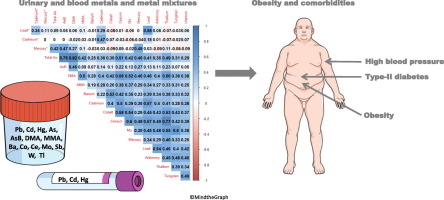Environment International ( IF 10.3 ) Pub Date : 2018-10-11 , DOI: 10.1016/j.envint.2018.09.035 Xin Wang 1 , Bhramar Mukherjee 2 , Sung Kyun Park 3

|
Background
Some heavy metals (e.g., arsenic, cadmium, lead, mercury) have been associated with obesity and obesity comorbidities. The analytical approach for those associations has typically focused on individual metals. There is a growing interest in evaluating the health effects of cumulative exposure to metal mixtures.
Objectives
We utilized our Environmental Risk Score (ERS), a summary measure to examine the risk of exposure to multi-pollutants in epidemiologic research, to evaluate the associations of cumulative exposure to a mixture of correlated heavy metals with obesity and its comorbidities including hypertension, and type-2 diabetes mellitus (T2DM) while accounting for high degree correlations and interactions among metal mixtures components.
Methods
We examined blood and urinary markers of 18 heavy metals among 9537 adults in NHANES 2003–2014. We randomly split data into a training set for the construction of ERS (n = 6675) and a testing set for the evaluation of its statistical performance (n = 2862). ERS of heavy metal mixtures was computed for waist circumference using adaptive elastic-net (AENET) with 189 predictors including 18 main effects, 18 squared terms, and 153 pairwise interactions of heavy metals. Regression analyses with complex survey designs were performed to assess the associations of ERS with other obesity measures, hypertension and T2DM.
Results
7 main effects (blood lead, blood cadmium, blood mercury, and urinary markers of monomethylarsonic acid (MMA), barium, mercury and thallium), 4 squared terms (blood cadmium, urinary cadmium, urinary antimony and urinary tungsten), and 7 pairwise interactions (blood lead & urinary cadmium, blood lead & urinary MMA, blood lead & urinary uranium, urinary cadmium & urinary MMA, urinary dimethylarsinic acid (DMA) & urinary tungsten, urinary MMA & urinary cobalt, and urinary lead & urinary antimony) were selected by AENET for construction of ERS of waist circumference-related metal mixtures. An increase in ERS from 10th percentile to 90th percentile in the overall study population was significantly associated with 4.50 kg/m2 (95% CI: 4.06, 4.94) higher BMI, 4.16 mm (95% CI: 3.56, 4.76) higher skinfold thickness, and 4.11 kg (95% CI: 0.83, 7.40) higher total body fat, independent of age, sex, race/ethnicity, education, smoking status, physical activity and NHANES cycle (Ps < 0.05). Significant associations of ERS with both hypertension and T2DM were also observed (Ps < 0.05).
Conclusions
Our study suggests that cumulative exposure to heavy metals as mixtures is associated with obesity and its related chronic conditions such as hypertension and T2DM. Additional research is needed to confirm these findings in longitudinal settings.
中文翻译:

NHANES 2003-2014 年美国成年人累积接触重金属混合物与肥胖及其合并症的关联
背景
一些重金属(例如砷、镉、铅、汞)与肥胖和肥胖合并症有关。这些关联的分析方法通常集中于单个金属。人们越来越关注评估累积接触金属混合物对健康的影响。
目标
我们利用环境风险评分 (ERS) 来评估流行病学研究中接触多种污染物的风险,以评估累积接触相关重金属混合物与肥胖及其合并症(包括高血压和高血压)之间的关系。 2 型糖尿病 (T2DM),同时考虑金属混合物成分之间的高度相关性和相互作用。
方法
我们在 2003-2014 年 NHANES 中检查了 9537 名成年人的血液和尿液中 18 种重金属标记物。我们将数据随机分为用于构建 ERS 的训练集( n = 6675)和用于评估其统计性能的测试集( n = 2862)。使用自适应弹性网 (AENET) 计算重金属混合物的 ERS 腰围,具有 189 个预测变量,包括 18 个主效应、18 个平方项和 153 个重金属配对相互作用。通过复杂的调查设计进行回归分析,以评估 ERS 与其他肥胖指标、高血压和 T2DM 的关联。
结果
7 个主效应(血铅、血镉、血汞和一甲基胂酸 (MMA)、钡、汞和铊的尿液标记物)、4 个平方项(血镉、尿镉、尿锑和尿钨)和 7 个成对项相互作用(血铅和尿镉、血铅和尿MMA、血铅和尿铀、尿镉和尿MMA、尿二甲基胂酸(DMA)和尿钨、尿MMA和尿钴、尿铅和尿锑)被 AENET 选择用于构建腰围相关金属混合物的 ERS。整个研究人群中 ERS 从第 10 个百分位数增加到第 90 个百分位数与 BMI 增加 4.50 kg/m 2 (95% CI: 4.06, 4.94)、皮褶厚度增加 4.16 mm (95% CI: 3.56, 4.76) 显着相关和 4.11 公斤(95% CI:0.83,7.40)较高的总体脂肪,与年龄、性别、种族/民族、教育程度、吸烟状况、体力活动和 NHANES 周期无关( Ps < 0.05)。还观察到 ERS 与高血压和 T2DM 显着相关( Ps < 0.05)。
结论
我们的研究表明,累积接触重金属混合物与肥胖及其相关慢性疾病(如高血压和 T2DM)有关。需要进行更多研究来证实纵向环境中的这些发现。











































 京公网安备 11010802027423号
京公网安备 11010802027423号